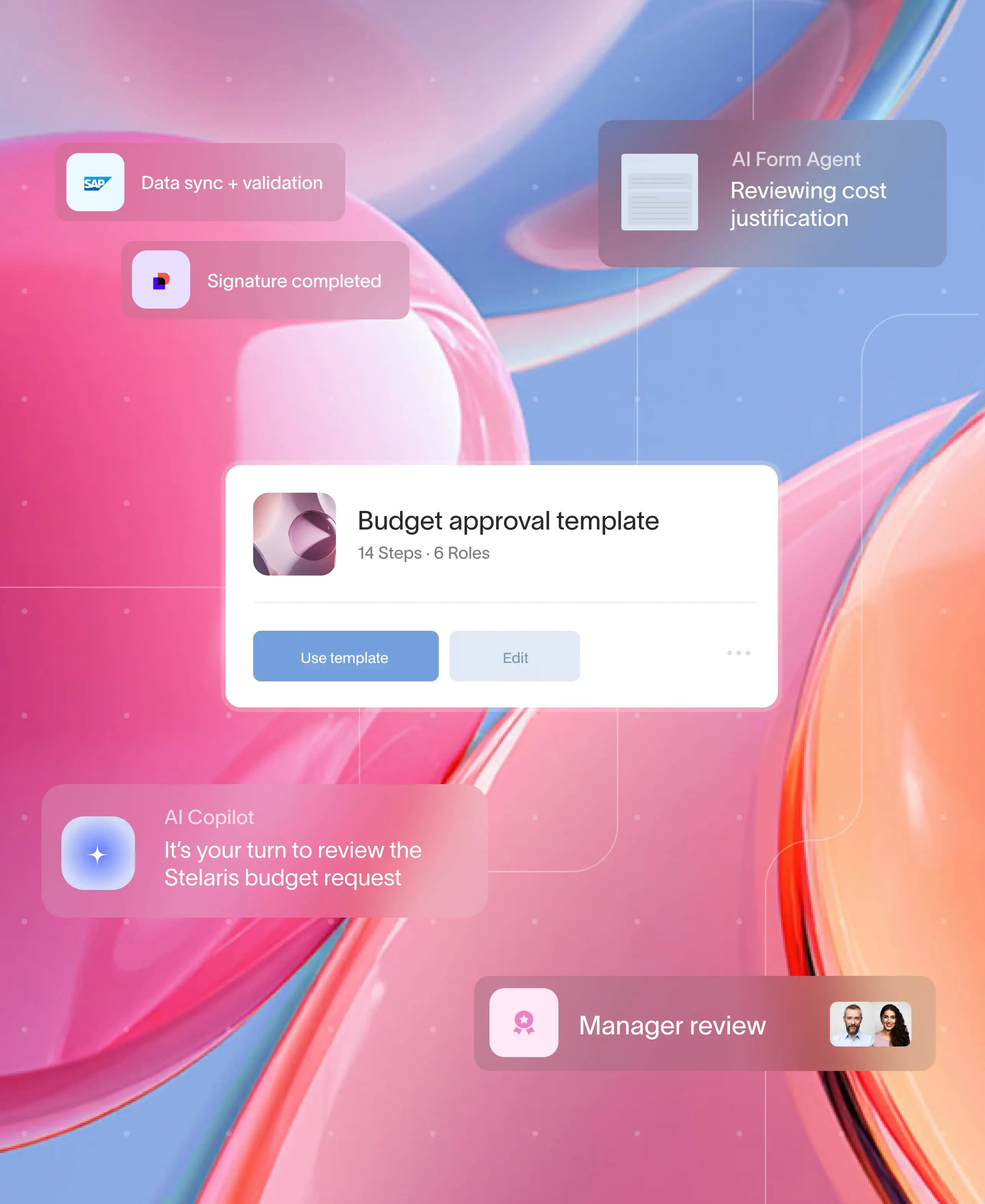
Moxo’s Laguna 9.11 release brings powerful enhancements to workflow automation, meeting flexibility, data sharing, and user control. With updates to milestone templates, dependency management, expanded branching logic, and improved automation capabilities, businesses can manage complex processes with even greater efficiency.
Milestone Template Enhancements
Milestone Templates now function as independent mini-Flows that can be seamlessly integrated into existing Flow templates and Flow workspaces. Previously limited to basic configurations, Milestone Templates now support a full range of Flow functions, including automations, branching, wait stages, and integrations.
Key enhancements
- Expanded Flow Capabilities: Add automations, conditional branching, decision branching, wait stages, and integrations.
- New UI Enhancement: A Details tab provides key milestone information, improving visibility and management.
- Dynamic Data Referencing (DDR) Support: Enables complex data handling within milestone templates.
Limitations
- Shadow Flows cannot be added within a Milestone Template.
- Nested Milestones are not supported; each template represents a single milestone.
Milestone Dependency & Custom Execution Order Support
This update enhances milestone management with greater flexibility, enabling businesses to efficiently coordinate complex, cross-functional processes. By configuring milestone dependencies, teams can better streamline project timelines and simplify operations at every stage. A new Enable Dependency option, available under Milestone Edit > Additional Options, provides precise control over how milestones progress within a workflow.
Key enhancements
- Execute Actions in Sequential Order: Ensures that all actions within a milestone execute step-by-step, even if the overall flow is parallel. If enabled, actions will follow a structured, sequential order within that milestone.
Note: When a flow is fully sequential, this setting is automatically applied. - Execute Actions in Parallel Order: If a flow is sequential, enabling this setting allows all actions within a milestone to run in parallel instead of sequentially. This toggle provides greater flexibility in execution.
- Enable Dependency: In a parallel flow, milestones can be configured to wait for dependent milestones to be completed before starting. Actions within the dependent milestone will only begin once the specified milestones are completed. Note: the Enable Dependency option is only available if the flow is parallel.
- Enhanced Workflow Coordination: This update allows teams to work concurrently while maintaining structured progression. By defining dependencies, businesses can ensure seamless execution, prevent bottlenecks, and improve collaboration across departments.
Example use cases
- Operations & Compliance: Compliance checks can be triggered only after risk assessments are completed.
- HR & Onboarding: Background verification must be finalized before an employee is assigned a team.
- Project Management: Multiple teams can work on different parts of the project in parallel, while dependencies ensure critical milestones are completed first.
Conditional & Decision Branching in Parallel Flows
Previously available only in sequential flows, conditional and decision branching is now supported in parallel flows, unlocking greater flexibility in managing complex processes.
Key enhancements
- Parallel Flow Branching: Use conditional and decision branching in parallel flows.
- Smarter Workflow Automation: Execute multiple branches simultaneously using logic-based conditions, enabling more complex workflows that dynamically adjust based on real-time inputs.
- Improved Efficiency: Reduce workflow delays by optimizing automation, ensuring smoother operations and minimizing manual intervention.
Support for Multiple Meeting Types
Moxo now offers more meeting options, allowing users to schedule Moxo Meetings, Zoom Meetings, or Offline Meetings based on their preferences.
Key highlights
- Organizations can configure Moxo (default), Zoom, and Offline meetings.
- A dropdown menu allows users to select the preferred meeting type during scheduling.
- Meeting-specific UI elements display settings relevant to each platform.
Considerations
- Once scheduled, meeting types cannot be changed. Users must cancel and reschedule the meeting in order to switch meeting types.
- Moxo’s audit tracking capabilities only apply to Moxo Meetings.
- Coming soon in a future release, the Time Booking action will also support scheduling multiple meeting types.
File DDR Support Between Main and Shadow Flows
Users can now share files seamlessly between main and Shadow flows using DDR.
Key benefits
- Bidirectional File Access: Easily share files across main and Shadow flows bidirectionally.
- Enhanced Workflow Efficiency: Automate file movement across interconnected processes without manual or repetitive uploads.
- Improved Collaboration: Teams can seamlessly access and exchange shared documents.
- Version Control Assurance: Reduces the risk of errors by maintaining a single, accurate file version across multiple workspaces, eliminating outdated or incorrect uploads.
Example use case
A finance team generates an invoice within a shadow flow, and the invoice is automatically pulled into the main flow for further action.
Archive Workspaces for Internal Users
A new archiving option lets you archive workspaces for internal users, while keeping them visible to clients.
Key benefits
- Helps internal teams declutter their timelines and clear out irrelevant workspaces.
- Clients retain access to their workspaces without disruption.
To-Do Automation Enhancement
Leverage DDR for the action title and file attachments when using automations to setup a To-Do.
Key benefits
- Personalized Titles: Automatically include client-specific details.
- Seamless Attachments: Attach relevant documents to To-Dos for quick reference.
Navigate to a Flow template or Flow workspace, go to Automations, select Create To-Do from Internal Automations, and leverage DDR for title, description, and attachments (via autofill option).
Example use case
When a client submits onboarding documents through a form, automate the creation of a To-Do in a group workspace. The client’s name is included in the title for easy identification, and the submitted documents are attached via DDR, eliminating manual uploads and ensuring quick access for review.
Enhanced Payload Customization for Outgoing Webhooks
Users can now customize the format of webhook payloads when sending data to external systems, improving integration flexibility.
Key benefits
- Supports a broader range of external systems by adapting data formatting.
- Ensures seamless interoperability with various third-party platforms.
“App Name + Event Name” in DDR
When using DDR, both the app name and event name are now displayed, improving clarity in workflow management. This helps users correlate the correct app name to the correct event name, eliminating potential confusion.
Key benefits
- Reduces confusion when identifying the correlating DDR references.
- Enhances workflow accuracy and efficiency.
Enable Waiting Room Enhancements
With this update, you now have more control over the meeting waiting room. Previously, all participants had to wait for host approval. Now, you can choose to enable the waiting room only for guests joining via the meeting link, while allowing internal users to join directly:
- Enable Waiting Room for Guests: External participants and client users will be placed in the waiting room until the host admits them, while internal members can join immediately.
- Enable Waiting Room for All: All participants, including internal team members, must wait in the waiting room and be admitted by the host before joining.
This ensures a smoother meeting experience, giving hosts better control over participant access and security.
Key enhancements
- Retry option: Participants who declined can now request to rejoin the meeting.
- Meeting hosts automatically bypass waiting room restrictions.
Additional enhancements
- Workspace Variables for Incoming Webhooks: Enables dynamic data passing when triggering flows from third-party platforms.
- Workspace Tags in DDR: Workspace tags can now be referenced in DDR.
- New Role-Based Permissions for Files: Allows granular control with role-based permissions for file movement and renaming.
- Phone Number Field in Flow Templates: Adds support for phone numbers in incoming payloads.
- Org-Level Message & File Deletion Settings: Allows different deletion time limits for internal and client users.
- Expanded REST API & Webhook Support: Workspace variables are now supported in REST APIs and webhooks.
- UX Tuning for Conditional Logic in Forms: Easily identify and search for correlated conditional logic in the form builder.
- Timeline Filter Logic Tuning for Workspace Tags: Users will now only see workspace tags from workspaces they are a part of.
Laguna 9.11: More control, better collaboration
Moxo’s Laguna 9.11 update introduces powerful enhancements across workflow automation, meeting management, data sharing, and user control. With upgraded milestone templates, dependency management, expanded branching support, and smarter automation capabilities, businesses can now orchestrate complex processes with greater efficiency and flexibility.
With integration enhancements, improved UI navigation, and enhanced automation, this release streamlines coordination and connectivity across processes for a more seamless experience.





